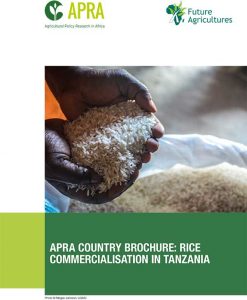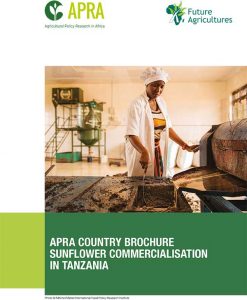RESEARCH
Contact Person: Aida Isinika | aidaisinika@yahoo.co.uk
Rice commercialisation in Tanzania
APRA is working in Tanzania to conduct quantitative and qualitative research to analyse the effects of different forms of rice commercialisation on poverty, food and nutrition security, and women’s empowerment in Kilombero Valley.
-
Research objective
This study aims to assess the effects of different rice commercialisation pathways on poverty, food security, and youths in Kilombero Valley.
-
Study questions
What are the drivers of rice commercialisation, and how can they inform policy and accelerate rice commercialisation in order to reduce poverty and food insecurity, especially among women and girls? What are the different commercialisation opportunities and options chosen by different groups, such as men, women, medium-scale farmers, and members of sustainable rice intensification (SRI) groups? What is the level of commercialisation attained by different categories of farmers, and are these influenced by the options chosen? How are different commercialisation opportunities associated with different livelihood outcomes, and how do they influence which farmers step out, step up, step in, hang in, or drop out of their original commercialisation options? Is commercialisation inclusive?
-
Findings
1. Trends • Rice commercialisation is ongoing but not yet on a sustained and rising trajectory; it remains susceptible to weather and market factors. • Infrastructure improvement (electrification, roads and communication) is accelerating commercialisation. • Trade policies need to be coherent and sensitive to consumer demand in regional markets. Tanzania should also plan ahead to maintain its position in regional markets, as other countries implement plans for self-sufficiency and become net rice exporters in the medium- and long-run. • Coordinated regional strategies are required in order to foster complementary competitive advantages among countries within regional economic blocks, as well as in Africa in general. The African Union can provide leadership in this regard, working with regional bodies such as the East African Community. • Rice is an important crop, which contributes to income and food security. However, issues faced by women and young people (i.e poorer access to inputs and land) in the production of rice is a challenge that still needs to be addressed. • Employment and value addition opportunities exist along the rice value chain for women and youths, but these groups continue to face resource and cultural barriers that need to be addressed. 2. Drivers of commercialisation: • Investment in public goods (improvements in roads, railways, mobile phone services and mobile money, and rural electrification). • Investment in private goods (processors establish more efficient mills where there is electricity). • Intensification (use of inputs, especially herbicides and fertilisers), and technological spill-over from large-scale investors (training and credit support for SRI groups). • Extensification (tools such as animal-drawn technology and tractors; immigration). • Diversity amongst the farming population is enhancing knowledge sharing within communities which drives competition to learn from each other, while also addressing negative cultural norms. • Increasing demand for rice as a result of the rising population, enhanced incomes, urbanisation, and a preference for aromatic rice at local and regional markets.
-
Conclusion and policy messages
Rice commercialisation in Kilombero Valley has been ongoing for a long time, but it has accelerated during the last two decades thanks to a number of drivers – especially public investment in infrastructure, which has improved transportation, communication, and processing. Some farmers, especially medium-scale farmers and SRI members, have been able to step up and some have stepped out, as they benefit from intensification, extensification, and diversification. However, the majority of farmers face low use of purchased inputs, especially purchased seed and chemical fertiliser, in turn leading to persistent low yield. Consequently, some small-scale farmers, especially women and youths, have been hanging in – while a few have dropped out to become casual labours as they face issues such as resource ownership and access gaps, as well as other shocks. The study’s findings raise concerns about the unmonitored and rising use of herbicides, which leads to water pollution. Uncoordinated expansion of rice production also has the potential to increase the siltation of rivers within the Kilombero Valley and further down the Rufiji Basin. Moreover, rice expansion into a protected wetland within the valley threatens biodiversity. Other problems, including climate change, COVID-19, rising input prices, and unstable output markets, have also tested the resilience of agricultural commercialisation outcomes. A ll of these challenges need to be addressed to ensure medium- and long-term sustainability of production systems and inclusive outcomes. Finally, the findings demonstrated that, while rising income is an important outcome of commercialisation, livelihood improvement also depends on how that income is used. Investments in education, and improvements in houses and latrines, have raised the status of many households to above the poverty line; and cultural factors play an important role to influence positive changes in this regard. Ultimately, promoting inclusive commercialisation requires combined efforts from the government, development agencies, and local communities. Policy messages • Support infrastructure and institution development to enable sustainable intensification and extensification, and intensification works for all, including women and youths. There is a need to monitor and address the negative effects arising from intensification and extensification. • Increase investment in health and education services and enforce health laws, especially in remote villages where women are more marginalised. • Support alternative income-generating activities and make them more inclusive for women and youths. • Involve local communities in devising solutions which address negative cultural norms to enhance the involvement of women and youths. • Make strategic moves to sustain and expand the regional market, and address the concern of increasing competition from imports and the drive towards self-sufficiency in regional markets.
Sunflower commercialisation in Tanzania
APRA is working in Tanzania to conduct quantitative and qualitative research to explore how different pathways of sunflower commercialisation have evolved over time to assess the dynamics of agrarian change, and how these have influenced the livelihood opportunities and outcomes for rural men and women in Singida Region.;
-
Research objective
This study aims to identify the role of sunflower commercialisation, and potential pathways for agricultural commercialisation, in a semi-arid environment. Specifically, it will examine how different pathways of sunflower commercialisation have evolved in Singida Region. It will also assess the changes that have occurred over time, and investigate how these have influenced livelihood opportunities/choices and livelihood outcomes for different categories of farmers.
-
Study questions
How have different pathways of sunflower commercialisation evolved in Singida Region? What are the dynamics of agrarian change? How have these influenced the livelihood opportunities/options, choices, and outcomes for rural women and men in different contexts?
-
Findings
• Sunflower commercialisation has stimulated diversification and changed livelihood options. Commercialisation has benefited other enterprises, but the reverse is also true. For instance, incomes from sunflower catalysed investments in high value crops, such as onions and green gram, in response to market dynamics. Likewise, income from other crops has been invested in sunflower production, marketing, and processing. Farmers depend on diverse sources of livelihood, both within and outside of agriculture. • Competition for land changed the management of livestock, such as distributing large herds to caretakers and migration to less densely populated districts. • Everyone benefitted from commercialisation in some respect, but at different levels as a result of social factors (such as gender, age, wealth status, and social behaviours). • Medium-scale farmers and male-headed households experienced greater food security and less impoverishment than small-scale farmers and female-headed households. • Some farmers stepped up (diversifying to onions, green gram, or livestock), while others (women and landless men) stagnated and some stepped down (into poorer wealth rankings) due to resource constraints. Key takeaways 1. Trends • During the 1990s, the government, development partners, and non-governmental organisations promoted sunflower production to help reduce poverty levels. This involved establishing the correct policies, mobilising resources, and developing technology, as well as supporting institutions and infrastructure development. • The private sector involvement was centred on trading and investment in transportation, processing, and financing. • Observed effects included an increased number of producers and processors, rising yields, and raised production levels between 2000–2010. After this time, however, yields declined as investments in technology development – particularly to support the production and distribution of improved seed – dwindled. • Relations between sunflower/other crops and livestock have been complementary – driven by rising use of animal-drawn technology (ADT) and manure. Competition for land saw large livestock herds driven to the west where grazing land was available; and some large herd owners redistributed their livestock to caretakers – spreading the benefits through communities. Livestock ownership is a local symbol of wealth and, as more people accumulate wealth from crop production, they acquire livestock. Therefore, the number of livestock per household has been increasing – although not for all. • Declining sunflower yields after 2010 have raised alternative opportunities. Other emerging crops (e.g., onions and chickpeas) and non-farm activities have widened the scope of livelihood options, leading to diversification. • Gender and cultural institutions, such as Nsoza and village community banks (VICOBA), can be utilised to enhance women’s inclusion in agricultural commercialisation processes. For example, they can increase opportunities for women to access resources such as land (under Nsoza) and purchased inputs using credit (from VICOBA). 2. Drivers of commercialisation: 2. Drivers of commercialisation: • There is a high demand for sunflower oil due to health reasons: this oil has a lower cholesterol content compared to alternatives. • Investment in public goods (such as trunk and rural roads that are now passable year-round, and mobile phone networks) and increased use of mobile phones. Rural electrification is bringing processing facilities closer to farmers. Solar technology has also improved the quality of life at the household level (for example, through improved lighting and mobile phone charging for enhanced communication). • Improved mobility through the use of motorcycles (which has benefitted from the improvement of rural roads that are passable year-round). • The availability of informal financing from traders and VICOBA. • The availability of informal financing from traders and VICOBA. • Use of ADT for cultivation, weeding, and transportation. • Renewed government efforts to prioritise sunflower production, under the Sunflower Policy of 2016. • Enhanced government efforts to promote crop diversity – for example, introducing cashew as a new cash crop in Singida Region.
-
Conclusion and policy messages
The findings show that sunflower commercialisation has played an important role in reducing poverty in the study area, driven by area expansion and initial yield improvement. Nevertheless, yields generally remain low due to underinvestment in technology development – which has also seen the use of poor-quality seed remaining high among farmers. Income from sunflower has supported diversification into other crops, including onions and green gram, and livestock and non-farm activities. With Singida Region’s fragile environment, diversification was necessary – but this has also led to competition for land, labour, and capital, as well as competition and complementarity among enterprises including livestock production. Consequently, some farmers stepped out into non-farm enterprises while others stepped in, investing proceeds into further sunflower expansion and improvement. Exclusion from such benefits is observed among women and youths, who stagnated or stepped down as they faced limitations in accessing land and credit for input acquisition. These limitations can be addressed through policy and institutional changes, as well as inclusive adaptation in light of climate challenges and changes. Other constraints, including various social vices, need to be addressed at the community level – perhaps with external facilitation in order to bring about positive behavioural and cultural changes. Policy messages • Facilitate the production of high-quality sunflower to consolidate import substitution. • Promote complementary enterprises based on their relative competitive advantages (in the use of land, labour, and capital) in the short, medium and long-term. • Control livestock populations to encourage communities to practice proper land use. • Promote alternative income generating activities to enhance household food security in marginal environments. • Ensure the availability of productivity-enhancing inputs and technologies at affordable prices. Expand markets and promote and harness savings while improving borrowing capacity to accelerate the development of the value chain.



